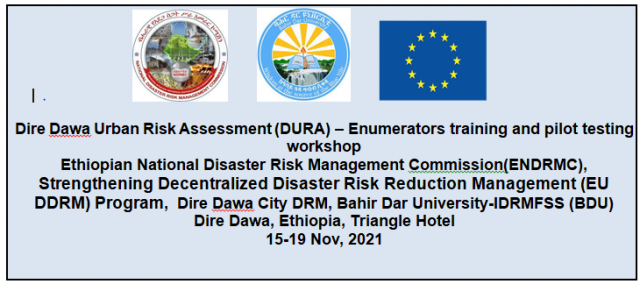
The Dire Dawa Urban risk assessment was formally launched on August 20, 2021, as previously stated. The enumerators’ training is the next phase, according to the agreed dates and tasks. As a result, on November 15 - 19, 2021, Dire Dawa Urban Risk Assessment (DURA) enumerators’ training was conducted in Dire Dawa city, Triangle hotel. The workshop had the following objectives
To Provide training to enumerators and other study teams on data gathering methods and techniques;
To undertake a pilot test of the questioners ad checklists
To familiarize the technical team with their roles and responsibilities for the primary data collection.
Bahir University, Institute of Disaster Risk Management and Food Security Studies (BDU-IDRMFSS) and Ethiopian National Disaster Risk Management Commission (ENDRMC) organized the training workshop with fund support of the European Union's Decentralized Disaster Risk Reduction Management (EU DDRM) Program and Dire Dawa City Disaster Risk Management Coordination office. Dr. Misganaw Teshager of BDU-IDRMFSS the DURA's technical leader takes the facilitation lead and facilitated the session success fully. As lead facilitator, Dr. Misganaw has presented the aim of the current meeting and outlining the activities completed in earlier phases. The Deputy Mayor of DD City has given welcome and opening statement, followed by important note speeches from the EDRMC and DRR directorate director.
Dire Dawa City Deputy Mayor, Ato Harbi commended BDU-IDRMFSS for embracing the commitment, particularly at this time when the regional conflict is raging and some services have been discontinued in over half of locations in the Amhara National Regional states, where the university is located. He has conveyed his pleasure that the activities had advanced to this point. In addition, he explained why conducting a vigorous and outstanding Urban Risk Assessment in Dire Dawa is important not only because it will guide disaster risk reduction plans, develop legal frameworks and provide other inputs for the planned wider Ethiopian Urban Risk Assessment, but it will also serve as a model for other Ethiopian cities.
Ato Harbi conclude his speech by thanking the workshop's organizers and directing the trainees to obtain a thorough understanding of the tools and to use what they've learned, as well as to have the necessary competence for the data quality aspired and to assist Dire Dawa city as citizens.
The key note speech was given by Ato Abraham Abebe, Director for the Disaster Risk Reduction directorate at the Ethiopian National Disaster Risk Management Commission, He also expressed his gratitude to BDU-IDRMFSS for its technical leadership of the DURA and European Union's Decentralized Disaster Risk Reduction Management (EU DDRM) Program and Dire Dawa City Disaster Risk Management Coordination Office for financing and hosting the workshop. He gave some background on the previous activities related to the DURA project that had already been completed. He reaffirmed and noted that the EDRMC, specifically his directorate, as well as the Dire Dawa City DRM, are committed to taking project operations to this level. Ato Abraham, who is a part of the technical team for the Dire Dawa urban risk assessment, expressed his delight that the project has gained a foothold and that we have now launched the Enumerators' training, which is critical for the quality of actual data collection. He emphasized the importance of data quality for this project because it will not only help to provide better findings, but it will also help to define next steps, such as disaster risk reduction planning.
The training was facilitated by Dr. Misganaw Teshager and Dr. Tesfahun Asmamaw on concentrating the overview of urban risk assessment methodology and the risk factors that had been identified through a series of discussions and consultations. I addition to participatory training in class rooms, Pilot testing was undertaken in three Kebele of Dire Dawa city on November 18, 2021. As a result, we were able to collect data from 23 households and we had a lively afternoon reflection from enumerator and supervisors. On the 19th, the technical team met to collect input from the workshop and field exercise, determine next steps, and conclude the meeting(Figure 1).
Figure 1.Eumerators training setup pictures
Finally, as a result of the workshop/training, the following goals were accomplished:
All survey teams, including 19 enumerators, 3 research assistants and 4 supervisors, were trained on the survey instruments and tools ad qualified to collect quality data.
The enumerators' training followed the usual scientific approach.
We also conducted a pilot test of the survey questionnaire, focus group discussion and key informant interview checklist and observation checklist, receiving input from the enumerators. This was done to not only qualify the instruments, but also to evaluate the enumerators.
Study, support and other research teams were also briefed on their responsibilities and roles.

